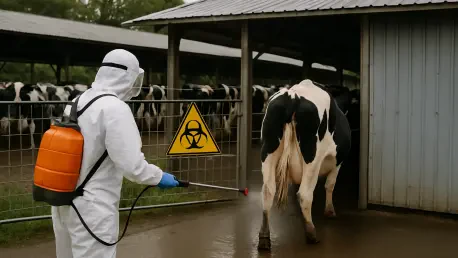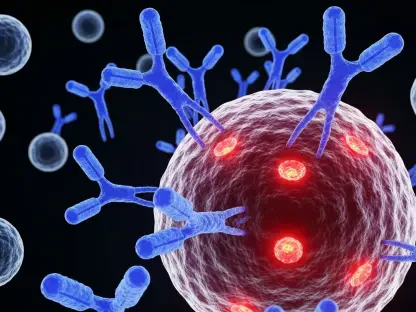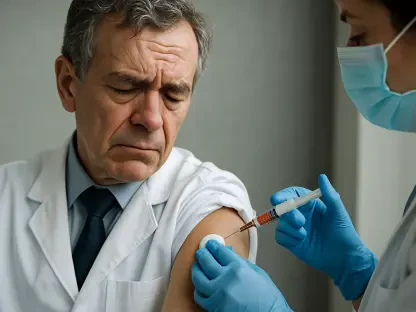In the heart of Michigan’s agricultural landscape, dairy farmers are grappling with an invisible yet formidable foe: Highly Pathogenic Avian Influenza (HPAI), a viral infection that has disrupted operations and threatened both animal and economic health. First detected on a Michigan dairy farm on March 29, 2024, this disease has since spread to 28 additional herds across the state, prompting urgent action and adaptation. While policies, laws, and testing requirements have evolved over the past year, the core challenge remains—protecting workers and animals from the costly impact of outbreaks. HPAI affects cattle with symptoms like reduced feed intake, decreased milk production, and fever, leading to significant financial losses estimated at $504 per affected cow. Amid these challenges, farm biosecurity plans and disease outbreak response strategies have emerged as critical tools for risk reduction, supported by resources from organizations like MSU Extension. This pressing issue underscores the need for proactive measures and robust planning in the dairy industry.
1. Understanding the Threat of HPAI and Safety Priorities
The emergence of Highly Pathogenic Avian Influenza in Michigan’s dairy sector has highlighted the urgent need for heightened safety measures to protect both workers and animals. Since its initial detection, the virus has posed a significant challenge, with affected cattle exhibiting a range of clinical signs such as diminished milk production, discolored milk, abnormal manure, and fever. Although mortality rates remain low, the economic toll is substantial, with studies estimating a net cost of $158 per cow in an impacted herd. This financial burden, coupled with the potential for rapid disease spread, emphasizes the importance of prioritizing safety protocols. A comprehensive biosecurity plan, while not a foolproof shield against outbreaks, serves as a vital component in minimizing risks. Additionally, disease response strategies enable farmers to address new or escalating outbreaks proactively, ensuring that the health of the herd and the workforce remains safeguarded against this persistent viral threat.
Beyond the immediate health concerns, the broader implications of HPAI outbreaks necessitate a deeper understanding of its transmission dynamics and impact on dairy operations. Policies and testing requirements have been updated to address the evolving situation, reflecting a statewide effort to curb the virus’s spread. Resources provided by MSU Extension and other agricultural support bodies have become invaluable for dairy producers seeking guidance on managing this crisis. These resources offer practical tools and educational materials to help farmers implement effective biosecurity measures tailored to their specific needs. The focus on safety extends beyond just animal welfare to include the well-being of farm staff, who are often on the front lines of handling infected herds. By fostering a culture of vigilance and preparedness, Michigan’s dairy industry aims to mitigate the devastating effects of HPAI, ensuring that both human and animal health are prioritized in the face of ongoing challenges and uncertainties.
2. Enhancing Biosecurity to Curb Transmission Risks
Addressing the spread of HPAI requires a critical look at past dairy practices that may have inadvertently facilitated transmission between cows and across herds. Activities such as staff moving between different farm locations, handling poultry alongside cattle, and neglecting to sanitize vehicles or equipment have been identified as potential contributors to the virus’s spread. While the precise mechanisms of transmission remain under study, reducing these risky behaviors offers a practical way to lower infection rates. Implementing stringent biosecurity measures is essential for protecting animal and human health alike. Key practices include isolating sick animals and tending to healthy ones first, limiting contact between cattle and wild or domestic birds through deterrents or fencing, and ensuring regular cleaning and disinfection of equipment, especially during movement between farm areas or after handling ill animals. These steps form the foundation of a robust defense against HPAI.
Further strengthening biosecurity involves additional protocols and a commitment to consistent execution across all farm operations. Wearing appropriate personal protective equipment (PPE) for tasks, maintaining its condition, and replacing damaged gear are crucial for minimizing exposure risks. Establishing clear contact protocols, such as knowing when to notify a veterinarian about health issues, ensures swift action during potential outbreaks. Farms should also define a line of separation or outer boundary with designated access points, incorporating features like parking areas and cleaning stations to prevent unauthorized or contaminated vehicles from entering. Employee education plays a pivotal role in this process, with many farms using bilingual written guidance and visual reminders to ensure compliance. By embedding these practices into daily routines, dairy operations can significantly reduce the likelihood of HPAI transmission, safeguarding both their herds and their livelihoods from this ongoing threat.
3. Implementing Disease Outbreak Response Protocols
When an infectious disease like HPAI strikes, its rapid spread through a herd demands immediate and coordinated action to contain the outbreak. A well-structured disease response plan is essential for managing such crises effectively. Key steps include promptly isolating animals showing clinical signs to prevent further infection, implementing movement restrictions on all animals at the farm to limit spread, and contacting a veterinarian for expert guidance. Additionally, conducting an inventory of all animals to identify and isolate those potentially exposed is critical. Close monitoring of herd health, guided by veterinary advice, involves taking temperatures and observing symptoms to detect issues early. Communication is equally important—ensuring that employees, visitors, vendors, and service providers are informed about biosecurity practices helps maintain a unified front against the disease, reducing the risk of inadvertent transmission during an outbreak.
Beyond these initial response measures, dairy farms must prepare for ancillary challenges that arise during an outbreak to maintain operational stability. Planning for safe carcass disposal, securing feed and other essential supplies, and navigating movement restrictions are vital considerations in managing the situation. Maintaining an up-to-date emergency contact list with local, state, and federal resources ensures quick access to support when needed. Keeping detailed animal health records also facilitates a rapid and informed response, enabling farmers to track the progression of the disease and adjust strategies accordingly. These comprehensive preparations help mitigate the broader impacts of an outbreak, from logistical disruptions to economic losses. By integrating these elements into a cohesive response plan, Michigan dairy farms can better withstand the pressures of HPAI outbreaks, protecting their operations and ensuring continuity in the face of infectious disease challenges.
4. Leveraging Support and Resources for Dairy Farmers
Navigating the complexities of HPAI requires access to reliable support and resources, and Michigan dairy farmers are fortunate to have several organizations dedicated to assisting them. The Animal and Plant Health Inspection Service (APHIS), Secure Milk Supply, Beef Quality Assurance, and the Michigan Department of Agriculture and Rural Development (MDARD) offer guidance on creating and updating farm biosecurity plans tailored to individual needs. MSU Extension Educators also provide hands-on support, with programs available in both English and Spanish that can be conducted directly on farms. Scheduling these sessions is straightforward—farmers need only reach out to the educator assigned to their county. The MSU Extension Dairy website further serves as a valuable hub, featuring news updates, contact information for dairy experts, and event listings to keep farmers informed and connected to the latest developments in disease management.
In addition to technical assistance, addressing the emotional and financial toll of managing herd health issues is a priority for support programs. MSU Extension recognizes the stress that uncertainty and outbreaks can cause, offering resources to help farmers cope. These include a free teletherapy program, stress reduction tools, and financial management assistance to alleviate the burdens that often accompany such challenges. This holistic approach ensures that dairy producers receive not only practical solutions for biosecurity and outbreak response but also support for their personal well-being and economic stability. By tapping into these diverse resources, farmers can build resilience against HPAI and other threats, fostering a stronger, more sustainable dairy industry in Michigan. The availability of such comprehensive aid underscores the collaborative effort to protect both the agricultural community and the broader food supply chain from the impacts of infectious diseases.
5. Staying Informed on Testing and Monitoring Efforts
Keeping abreast of testing protocols is crucial for Michigan dairy farmers as they combat HPAI, and recent updates have made this process more accessible. As of May this year, APHIS has implemented free livestock testing through two national laboratory networks, covering samples collected under the National Milk Testing Strategy, before interstate movement under specific conditions, and through the voluntary dairy herd status program. This initiative ensures that farmers can monitor their herds without the added financial burden, facilitating early detection and response to potential outbreaks. Such testing efforts are a cornerstone of managing the spread of HPAI, providing critical data to inform biosecurity measures and movement controls. Staying updated on these programs allows dairy producers to align their operations with federal guidelines, ensuring compliance while protecting their herds from the pervasive threat of this viral infection.
In parallel, Michigan-specific testing initiatives further bolster the state’s response to HPAI, with MDARD playing a pivotal role in collaboration with milk cooperatives. Monthly milk samples are collected and sent from farms or cooperative laboratories to the Michigan State University Veterinary Diagnostic Lab (VDL) for screening. Samples testing positive for HPAI are forwarded to a federal lab for confirmation, maintaining strict confidentiality of individual results to protect farmers’ privacy. This systematic approach to monitoring helps track the prevalence of the virus across the state, enabling targeted interventions where needed. By participating in these testing efforts, dairy farmers contribute to a broader understanding of HPAI’s impact while gaining insights into the health status of their own herds. These combined federal and state initiatives reflect a commitment to safeguarding Michigan’s dairy industry through rigorous and accessible testing protocols.
6. Building a Resilient Future for Dairy Operations
Reflecting on the strides made in combating HPAI, Michigan dairy farms have demonstrated remarkable adaptability in implementing biosecurity plans and outbreak response protocols over the past year. The focus on isolating sick animals, restricting movement, and maintaining rigorous sanitation standards proved instrumental in curbing the virus’s spread. Collaborations with veterinarians and support from organizations like APHIS and MSU Extension provided a backbone of expertise and resources that fortified these efforts. Testing initiatives, both at the federal and state levels, played a critical role in identifying and managing outbreaks, ensuring that responses were timely and data-driven. These collective actions not only mitigated immediate losses but also laid the groundwork for long-term strategies to protect herds from future threats, showcasing the industry’s capacity to evolve under pressure.
Looking ahead, the path to resilience involves continued vigilance and the integration of lessons learned into everyday practices. Dairy farmers are encouraged to regularly update their biosecurity plans, incorporating new research on transmission risks and prevention methods as it becomes available. Engaging with ongoing training programs and stress management resources will further equip them to handle the multifaceted challenges of disease outbreaks. Strengthening partnerships with local and federal agencies can streamline access to testing and emergency support, ensuring rapid responses to emerging issues. By fostering a culture of proactive planning and community collaboration, Michigan’s dairy industry can safeguard its future, turning past challenges into actionable insights for sustained health and productivity of both animals and operations.









